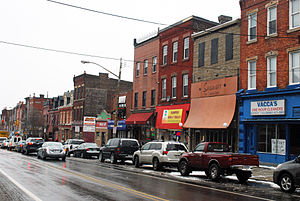Bloomfield (Pittsburgh)
Bloomfield | |
|---|---|
 View of Liberty Avenue in Bloomfield. | |
 | |
| Country | United States |
| State | Pennsylvania |
| County | Allegheny County |
| City | Pittsburgh |
| Area | |
• Total | 0.702 sq mi (1.82 km2) |
| Population (2010)[1] | |
• Total | 8,442 |
| • Density | 12,000/sq mi (4,600/km2) |
Bloomfield is a neighborhood in Pittsburgh; it is located three miles (5 km) from the Golden Triangle, which is the city's center, and is represented on Pittsburgh City Council by Patrick Dowd and Bill Peduto. Bloomfield is referred to as Pittsburgh's Little Italy. Pittsburgh architectural historian, Franklin Toker, has said that Bloomfield "is a feast, as rich to the eyes as the homemade tortellini and cannoli in its shop windows are to the stomach."[2] The residents are diverse as the neighborhood has a combination of working class Italian-Americans, various other European populations, African-Americans, and a substantial population of college students[citation needed]. It is a decidedly urban neighborhood, with narrow streets and alleys packed with rowhouses. Liberty Avenue is the neighborhood's main business thoroughfare.
Location
Bloomfield is a plateau above the Allegheny River, and is bordered by Penn Avenue on the north, the East Busway on the south, 40th Street on the west, and Gross Street on the east. This last boundary is somewhat disputed – many residents believe that Bloomfield abuts the neighborhood of Friendship at Gross Street, where the provincial frame rowhouses give way to stand-alone brick Victorian homes that grow larger on each street heading east. The City of Pittsburgh, however, claims that Bloomfield extends east as far as Graham Street. The East Busway is set in a valley that separates Bloomfield from Polish Hill, the Hill District and Shadyside; the neighborhoods are within sight of one another, and are connected by the Bloomfield Bridge and the South Millvale Bridge, both of which span this gap.
Every year the Bloomfield Business Association hosts the Little Italy Days Festival.
History
Bloomfield appears to have been an independent borough prior to its annexation by the City of Pittsburgh in 1868. The land here was claimed from the native Delaware tribe by Casper Taub, one of the area's earliest European settlers. Taub sold the land to his son-in-law John Conrad Winebiddle, whose descendants then broke it into lots and sold it beginning around the time of the 1868 annexation.
In the decades following 1868, Bloomfield was settled by German Catholic immigrants, who in 1886 built St. Joseph's Church. Beginning around 1900, these were joined by Italians from five towns in the Abruzzi region, who formed Immaculate Conception Parish in 1905 (that church was rebuilt in its present form in 1961). Descendants from both groups, with the Italians outnumbering the Germans, still give the neighborhood its character today.
This character can perhaps best be described as earthy, gritty, close-knit, and proud; as local author Chris Potter puts it, "Bloomfield has always taken pride in its modest working-class aspirations and a lack of...upper-class trappings."[citation needed] The local rowhouses, constructed mostly of wooden frames covered long ago by aluminum siding, have unpretentious exteriors that often conceal lovingly maintained interiors.
The business district along Liberty Avenue puts most of life's necessities, and several luxuries, within an easy walk of Bloomfield residents: besides the two churches and West Penn Hospital, there are many bars and restaurants, one supermarket and two Italian markets, plus tanning and hair salons, gift and card shops, gyms, two barber shops, a cobbler, a vacuum repairman, and much more. Many restaurants serve Italian cuisine, although the neighborhood does feature a noted Polish restaurant. There are also two Thai and two Chinese restaurants on Liberty Avenue.
Sport
The Bloomfield Bridge played a role in the life of the Baltimore Colts' Hall of Fame quarterback, Pittsburgh native Johnny Unitas. After being cut by the Pittsburgh Steelers in 1955, Unitas played one season for the semipro Bloomfield Rams on Dean's Field under the bridge. Unitas has died, and the semipro league has long since folded. The Bloomfield Rams no longer exist and the former Dean's Field was renamed in honor of the fallen Pittsburgh Police officer Paul J Sciullo II. Officer Paul J. Sciullo Memorial Field is now part of a recreational complex.
References
- ^ a b Template:Cite article
- ^ Toker, Franklin (1994) [1986]. Pittsburgh: An Urban Portrait. Pittsburgh: University of Pittsburgh Press. ISBN 0-8229-5434-6.
See also
- List of Pittsburgh neighborhoods
- The Bulletin (Pittsburgh), a monthly community newspaper serving Bloomfield
- Post-Gazette article on "hipness factor"

